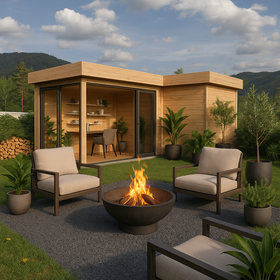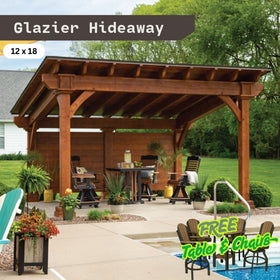512-777-0154

8 Pergola Ideas for 365 Days of Outdoor Living
When the temperatures dip or the rain rolls in, most people pack up their outdoor space and wait for spring. Cushions go into storage. Grills stay cold. The patio becomes a ghost town.
But it doesn’t have to be that way.
A well-designed pergola and outdoor living room can change how you use your backyard, 365 days a year. It’s not just for summer shade or climbing plants on a trellis. With a few smart upgrades, a pergola can handle heatwaves, cold snaps, rainstorms, and everything in between.
You don’t need a massive makeover or a full outdoor kitchen with a barbecue grill or pizza oven to make it work, either. Just a few simple ideas, layered the right way, can turn your patio into a space that's used year-round.
Want to sip coffee outside on a foggy morning? You can. Host a cozy dinner in December? Also possible. Enjoy late-night chats under the stars without freezing? Absolutely doable.
The point is, your outdoor living space shouldn’t come with an expiration date.
So if you're tired of only using your backyard or garden for three months out of the year, you’re in the right place.
1. A Retractable Canopy Pergola That Plays Along With the Weather
One minute it’s sunny, the next it’s drizzling.
If that sounds like your climate, a retractable canopy pergola might be the move.
Think of it as outdoor weather control, without the price tag of a full roof. You can slide the canopy open when the skies are clear, and close it up when the clouds roll in. Shade when you need it, sunlight when you want it.
It works for more than just summer. Spring showers? No problem. Fall breeze? Still comfortable. Even crisp winter mornings are fair game when the canopy keeps the dew off your seat.
Go for a light, waterproof fabric that dries quickly and won’t trap heat. If your outdoor living setup allows, choose a neutral color that doesn’t fade easily and blends with the season.
Manual or motorized? Up to you. Either way, you’ll be using your backyard more than you think.
2. A Pergola With a Built-In Heater
Cold weather hits, and the patio usually gets shut down. But add a heater to your pergola, and you’ve got options.
Some electric models mount neatly to overhead beams. Some tuck into the corners and aim heat where you want it. Others hang from above like a pendant light.
Propane works too, especially for freestanding setups. Just make sure it’s got enough clearance and isn’t blasting heat into the rafters.
Either way, you get a more usable space when the temperature drops. Morning coffee under the heater? Works. Dinner in November without coats? Also works.
If you live somewhere with snow, look for models rated for outdoor, year-round use. Some are designed to stay up all season. Others you’ll want to store between uses.
Just check the fire safety recommendations before installing. Most heaters are safe when mounted correctly, but every pergola setup is a little different.
3. Go Green With a Living Roof Pergola
Climbing plants and pergolas just work. Wisteria, ivy, grapevines, any of these can turn a bare Outdoor Living Today Western Red Cedar Pergola & Canopy into something layered, soft, and shady. That’s the idea behind a living roof.
In summer, dense foliage blocks harsh light and cools the space naturally. In spring and fall, you get seasonal color. And in winter? The bare vines add a sculptural, almost architectural feel.
It’s not just about looks either. A living roof can help reduce heat, absorb sound, and make your backyard feel more connected to nature.
If you’re after something low-maintenance, go for hardy plants that don’t need constant pruning. Bonus points if they’re native to your region. String some lights across the beams, and you’ve got an evening space that still feels alive even in colder months.
Just remember, living roofs take a little patience. But once they fill in, you get a pergola that shifts with the seasons and doesn’t need much else to feel complete.
4. A Pergola With Drop-Down Weather Screens
Sometimes it’s not the temperature that ruins the vibe, it’s the wind, the glare, or the sideways rain.
Drop-down screens fix that.
These attach to the sides of your Brookside Timber Frame Timber Resort Pergola and roll down when you need extra coverage. You can get them in thick fabric, vinyl, or mesh, depending on what you’re trying to block.
Vinyl is a solid choice if you want to keep your view. Mesh lets in airflow while keeping bugs out. Fabric gives you shade and privacy but blocks more light.
They’re also a nice way to make your pergola feel more like a room, especially in colder months. You cut the wind and trap a little heat without sealing the whole thing off.
Manual screens cost less and work fine for most setups. But if you’re building new or upgrading, motorized ones are cleaner and faster to use.
5. Add a Pergola With Built-In Lighting
Lighting isn’t just about setting the mood. It’s about making the space usable when the sun taps out early. Built-in lights give your pergola more purpose, especially in fall and winter when daylight runs out fast.
You’ve got options. LED strips along the beams. Wall sconces if your pergola’s near the house. Pendant lights overhead if you want a centerpiece.
Warm-toned bulbs make the space feel cozy. Color-changing ones give you flexibility for gatherings or quiet evenings. Solar-powered lights are great if you want a lower energy bill and fewer wires. Just make sure the panels get enough sun to charge during shorter winter days.
Lighting also helps with visibility and safety. No more stumbling around in the dark when you’re just trying to grab another blanket.
It’s a simple upgrade that makes your Structureworks Breeze Aluminum Pergola less seasonal and more dependable. And once it’s wired in, you’ll probably use it more than you think.
6. All-Weather Pergola Materials That Don’t Flinch at Rain or Snow
Some materials just aren’t cut out for year-round life outdoors. If you want a Structureworks Stratus Aluminum Pergola that holds up through storms, sun, and snow, you’ll need to choose the right stuff.
Aluminum is lightweight and won’t rust. Steel’s stronger but needs a powder-coated finish to resist corrosion. Pressure-treated wood? It holds up well, but it’ll need occasional maintenance. Composite materials cost more upfront but offer a long-term, low-maintenance option.
This isn’t really about looks. It’s about not having to rebuild or repaint after one rough season.
Live somewhere that sees snow? Consider a sloped roof design so snow doesn’t pile up and stress the frame. You’ll also want to double-check the load ratings before choosing your build.
Add weatherproof fasteners and anchoring while you're at it. Small things, but they make a difference when storms hit.
With the right materials, you get peace of mind and a structure that’s not seasonal, but steady.
7. Cozy It Up With an Outdoor Fireplace or Fire Pit
Add a heat source to your Structureworks Reverie Fiberglass Pergola and everything changes.
Suddenly, winter isn’t a reason to stay inside. A fire pit or fireplace can turn a cool, empty space into somewhere you want to sit. And stay.
Wood-burning options give you the crackle and smell, but they’ll need ventilation and spacing. Gas models are cleaner and easier to start, but less dramatic. Both have their perks, depending on what you care about more.
You’ll need to think about clearance, airflow, and local codes before adding fire. Some pergolas handle it better than others. And if you’re building from scratch, it’s easier to plan around.
Once it’s in place, you’re free to layer in the details. Low outdoor seating with a chair or sofa with thick cushions. Blankets within reach. Maybe a small coffee table for drinks or snacks.
A heat source changes how you use the space and when you use it. Suddenly, winter isn’t off-limits. It’s just another season to be outside.
8. Mix It All Up
You don’t have to choose just one upgrade. If your goal is year-round use, the best approach might be to build a Brookside Timber Frame Shadelan Retreat Pergola that wears different hats.
Start with a structure, something solid enough to handle the weather and that has waterproofing. Then layer in function. A retractable shade for summer. Drop-down screens for wind. Lighting for late nights. A heater or fire feature for colder days.
You don’t need to do it all at once. Start small. Add pieces as you go and see what gets used.
Eventually, you’ve got something that feels less like a patio cover and more like an outdoor living room. A space that works just as well for summer BBQs, grilling, outdoor cooking, and lounging in a hot tub or swimming pool as it does for winter stargazing.
It’s not about making your backyard or deck fancy. It’s about making it usable. And once it’s usable, you’ll probably use it more than you thought. Even when the weather’s not perfect.
That’s kind of the whole point. A pergola that’s built to stretch across seasons. Without needing perfect conditions to enjoy it.
Why a Year-Round Pergola Just Makes Sense
There’s something different about having a space outside that works no matter the season.
You start spending more time in your outdoor oasis. Morning coffee, casual dinners, quiet nights that don’t need a reason. It becomes part of your routine, not just a summer thing.
And you don’t need a huge budget to get there. A simple heater, some lighting, maybe a couple of drop-down screens, and suddenly the patio doesn’t sit empty all winter.
Add an outdoor rug to take the chill off your feet. Pull in a few pieces of weather-resistant outdoor furniture. You don’t need to design an outdoor showroom. Just make it comfortable enough that you want to sit and stay.
It’s not about perfection. It’s about creating a space that feels like yours, even when the weather isn’t playing nice.
And if you want more ideas, our blogs dive deeper into outdoor setups that work in real life.











